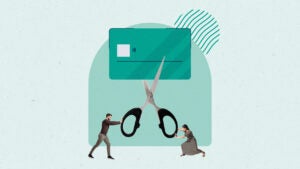7 steps to remove old debt from your credit report

Key takeaways
- Unpaid debts and accounts in collections will stay on your credit report for seven years.
- Removing old debt from your credit report may help improve your score.
- Steps you can take include filing a dispute with the credit bureaus or enlisting the help of a credit repair company.
Have you recently discovered old debt is impacting your credit score? You’re not alone. American consumers collectively owed $17.57 trillion in debt as of Q3 2024.
Old debts don’t have to mess up your credit score. You can take steps to remove old debts from your credit report in many cases. Even if you can’t remove unpaid debts from your credit report, you can take steps to improve your credit.
1. Confirm the debt should be removed
Before taking any action to get old debt removed, take the time to understand where the debt is being reported, how old it is and whether or not you paid it off.
To find out which credit reports include old debts, request copies of your reports from all three of the consumer reporting agencies — Equifax, Experian and TransUnion — at AnnualCreditReport.com. The old debt in question might be listed in some credit reports but not others.
Verify the age of your debt by counting from the date on which you first became delinquent. For example, if you missed your March 2018 payment and your bill eventually went into default, your delinquency date would be March 2018. No matter how many times a debt is sold (and resold), the date that counts for old debt is the date of delinquency with the original creditor.
Look back through your records to verify the payment history for old debts. Confirm whether you paid off the account, and if so, if you paid the original creditor or a collection agency.
2. Wait for the old debt to fall off
Old debts don’t remain on your credit report forever. Debts are automatically removed from your credit report once they reach their legal expiration date.
Unpaid debts and delinquent accounts can remain on your credit report for seven years. Collection accounts will also remain on your credit report for seven years, even if you paid the collection agency.
If your old debt has almost reached the seven-year mark, waiting for it to fall off your credit report is likely the easiest option. If the debt is still on your report after the seven-year timeline has passed, you can take other steps to get it removed.
3. Ask for a goodwill deletion
Sometimes, it’s possible to get a collection account removed sooner than seven years. If there’s an old collection account listed on your credit report, but you already paid off the debt, consider asking the collection agency to delete the account as a gesture of goodwill.
Call or write the collection agency to explain why you want the account deleted, such as that you’re hoping to get a mortgage. Explain the circumstances that led to the account being sent to collections. There’s no guarantee that the collection agency will agree, but there’s no harm in asking.
4. Dispute the error with the credit bureaus
Sometimes, debts remain on your credit report longer than they should. If an old debt remains on your credit report after seven years, it’s time to contact the credit bureau(s) and dispute the error.
To file a dispute, contact each credit bureau that’s incorrectly reporting the old debt by phone, mail or online. Be prepared to provide any documentation that supports your claim, such as a letter or statement from your original creditor showing when the account became delinquent.
After receiving your dispute, the bureau will open an investigation and contact the creditor reporting the debt. The Fair Credit Reporting Act requires credit bureaus to correct or delete any information that can’t be verified or that is incorrect or incomplete, typically within 30 days. If the creditor can’t verify the debt, it has to come off your report.
5. Hire a credit repair company
If an old debt is still on your credit report after it should have fallen off, you don’t necessarily need to dispute the error on your own. Credit repair companies can help you clean up errors on your credit report.
Credit repair companies work by identifying errors on your credit report and filing disputes on your behalf. Some can also offer help with other steps for removing old debt, like writing goodwill letters. If you choose to take this step, be sure to choose a reputable credit repair company.
6. Send a letter to the reporting creditor
If an old debt is still on your credit report after the seven-year timeline, you may also want to send a letter to the creditor who’s currently reporting the debt. Depending on who your creditor is, it may be faster to work directly with the creditor to get your old debt off your credit report.
To do this, either reframe your credit bureau letter with copies of your documentation to the creditor or simply send a copy of the same letter with copies of any documents included. Avoid making statements that could restart the debt clock if the statute of limitations has not expired.
The creditor has 30 days to investigate your claims and respond.
7. File a complaint
If you’ve already contacted the credit bureaus and your creditors, but the issue has not been resolved, it may be time to try more targeted methods. One option is to complain to someone higher up in the company reporting the debt.
“Direct your next letter to the president’s attention at the company’s headquarters address,” says Sonya Smith-Valentine, former managing attorney at Valentine Legal Group “because you get a different kind of response from the office of the president than you do from customer service.”
You can also file a complaint with the Consumer Financial Protection Bureau. The CFPB forwards complaints to companies and publishes them in its public database, which can help you get a response.
Note: As of February 2025, the Trump administration has halted the work of the CFPB. If you are unable to file a complaint with the CFPB, you can also file a complaint with your state attorney general.
8. Talk to an attorney
If you’ve tried the other options but are still having trouble getting old debt off your credit report, consider contacting an attorney for assistance. Consulting an attorney doesn’t always mean pursuing a lawsuit. Sometimes, all you need is a letter on legal stationery to get your case seen by the correct people.
If, despite your best efforts, the creditor or collector is keeping old debt on your report, an attorney can also advise you as to whether a lawsuit is a good option.
If you do talk to an attorney, choose one who specializes in consumer rights, Smith-Valentine says. “When you’re dealing with the Fair Credit Reporting Act, it is very convoluted and you need someone who’s done it, who understands it and who knows where the holes are.”
One source for help is the National Association of Consumer Advocates, an organization of lawyers who specialize in credit and debt law.
The bottom line
Seeing old debt on your credit report can be discouraging when you’ve taken steps to improve your finances and credit score. Depending on how old the debt is and whether you’ve paid it, you may be able to take strategic steps to get the debt removed from your report. For help getting started, consider reaching out to a credit repair company.







